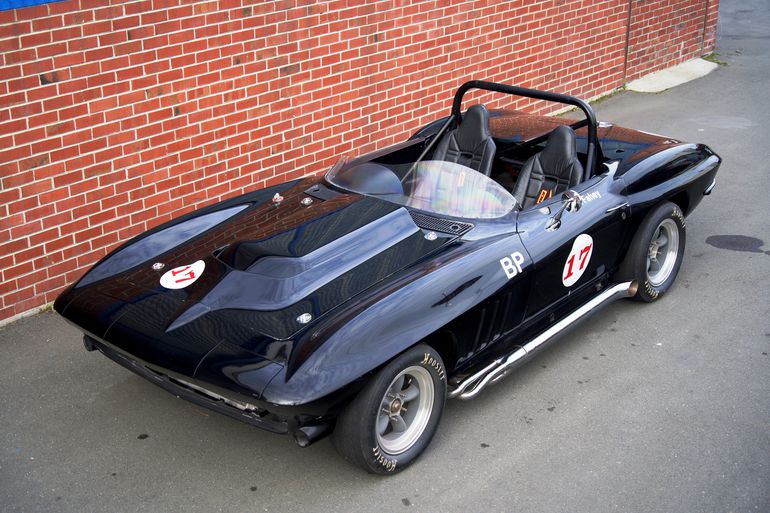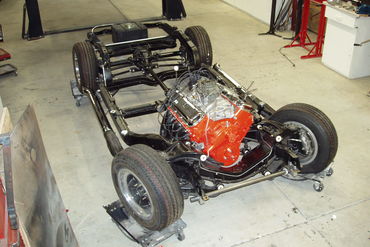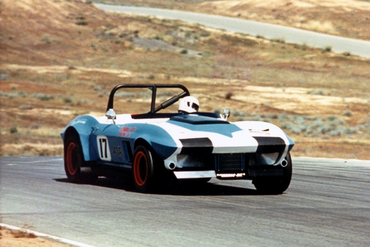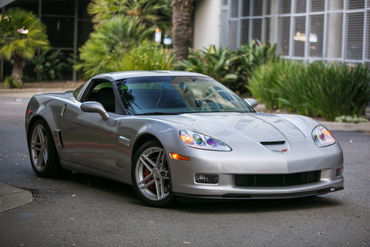Sold
SOLD 03/22
1966 Chevrolet
Corvette race car
Bring a Trailer NO RESERVE auction preview: Period IMSA racing history with 1975 SCCA Runoffs winner Frank Fahey and featured on the Registry of Corvette Racecars. Fresh engine and driveline to SCCA B Production specifications, California titled and plated for road use.
- VIN194676S123839
- Exterior ColorBlack
- Interior ColorBlack leather
- MileageTMU
- EngineSmall block V8 with solid lifters
- TransmissionMuncie M22 4-Speed
- StatusSold
- StockFJ2569
Description
1966 Chevrolet Corvette Race Car
VIN – 194676S123839
Exterior Color – Black
Interior Color – Black
Engine – B-Production legal Solid Lifter 327 cu. in V8
Transmission – 4-speed manual Muncie with M22
Current Miles – 1,032 TMU
Highlights of This Car
One of 13 factory M22 “Rock Crusher” Muncie heavy-duty close-ratio 4-speeds
Originally delivered with 427/425hp engine and M22 transmission
Originally painted black with racing history since 1966, San Diego, CA
Raced in period by Frank Fahey in IMSA and SSCA with seven 2nd places in a row in A Sport
General Overview
Regarded as one of the most important sports cars of the 20th century, the Corvette arrived in 1953 with the promise of sporty driving for performance-minded enthusiasts. By the late 50s however, the Corvette had evolved into a performance machine capable of besting European competitors in a variety of racing events. With Zora Duntov adding his special racing touches and the newly penned Pete Brock/Larry Shinoda 1963 Stingray, the Corvette stepped up with independent rear suspension, disc brakes, fuel-injection and by the mid 60s the incomparable big block cars were capturing checkered flags at street races and racetracks around the world. Well balanced, beautifully styled, and powerfully equipped, mid-sixties big block Corvettes continue to capture the imagination of Corvette enthusiasts offering fantastic vintage racing opportunities for skilled drivers who enjoy piloting highly capable performance cars.
History of This Car
The factory VIN for this car is decoded with the following information:
1 – Chevrolet
94 – Corvette
67 – 2-Door Convertible
6 – Model Year (1966)
S – St. Louis, MO manufacturing plant
123839 – Production Sequence Number
900 – Paint, Tuxedo Black
66 467 – 1966 Convertible
420 – Medium Saddle Vinyl Interior
A-7569 – Body Number
J31 – June 31, 1966
According to information listed in the Corvette Registry, this C2 Corvette was delivered from the factory with the 427/425 hp engine and is reported to be one of thirteen outfitted from the factory with the ultra-rare M22 Muncie “Rock Crusher” heavy-duty close-ratio 4-speed transmission. Originally delivered in black with a tan interior, it was immediately transformed into racing configuration painted red, white, and blue and outfitted with wider wheels and tires. In this configuration, the car raced as #17 in IMSA and SCCA competition with Frank Fahey at the wheel. During Fahey’s ownership, he drove this car in the following IMSA races:
IMSA GT Laguna Seca Raceway, May 12, 1974
IMSA GT Laguna Seca Raceway, May 12, 1974
IMSA GT 4 Hours of Ontario, Ontario Motor Speedway, May 19, 1974
IMSA GT Laguna Seca Raceway, May 3, 1975
IMSA GT 6 Hours of Riverside, Riverside International Raceway, May 10, 1975
http://ultimateracinghistory.c...
The car was sold to the second owner, Michael Mirk who converted it to run as an SCCA B-Production racer and continued racing on the west coast with the #56. Known races at that time included:
Sears Point, July 1977 – 12th place
Road Atlanta, Sept 1977 – 33rd place
Laguna Seca, October 1977 – 36th place
In 1978 the car was sold to the third owner who intended to restore it to factory condition. After remaining essentially untouched for another 24 years, the car was then sold to the fourth and current owner. At that time, the car was complete, but purchased without an engine or transmission. The body was removed from the frame and the owner embarked on a comprehensive restoration, electing to preserve the racing history, retaining as much of the competition features that had been a part of the car since new.
The restoration addressed many mechanical features of the car as the owner intended to use it for vintage racing events. The 327 cu. in. V8 engine currently installed in the car was built by Competition Engineering, Campbell, CA. Topped with a Holley four-barrel carburetor, the engine was specifically built to meet B-Production specifications using stock replacement heads, solid lifters, stock valve sizing, and stock plug angle, compliant with historic racing requirements for B-Production racing. The engine currently has approximately 10 hours of run time. The transmission was rebuilt by All Standard Transmission, Campbell, CA and the Positraction rear end uses 4:11 gearing. The body was painted using acrylic lacquer and the hood was configured to be removable. As the car had been previously prepared for racing duty, the clean, low-profile body was retained, a low-cut windscreen installed, the fender profile returned to stock configuration, and exterior details were prepared to reflect a historically correct racecar from the era, while retaining as much of the configuration Fahey had originally constructed for racing.
Condition Overview
Today this 1966 Corvette race car presents as a very capable vintage racecar but has only been driven on the street since the restoration was completed. The cosmetic finishes and older thoughtful preparation are evident in the overall condition; however, a comprehensive mechanical evaluation is recommended before using this car in a competition setting. The paint is glossy throughout, and the body panels display good fit, with finish and construction consistent with properly prepared vintage racecars. The car displays a few stone chips and scuff marks typical of competition finishes, but otherwise, the overall condition is quite impressive particularly in gloss black. The dramatic full-length hood bulge, curved plexiglass windscreen, chrome side pipes, and lack of trim closely convey the competition themes of the original Corvette XP87 race car designed by Pete Brock. The hunkered down stance is perfectly positioned on Torque Thrust American wheels shod with raised letter Hoosier racing tires, barely tucked under the powerful fender flares uniquely announcing the distinct C2 Corvette fender line.
The interior is properly finished for racing duty, with key elements reflective of the original configuration. The interior has been significantly lightened, removing all glass, windshield frame, side glass frames, convertible top, and all interior trim. The effective interior is built to the bare minimum, just as one might expect saving as much weight as possible. The dashboard was pared down to the twin binnacle structure and fitted with key instrumentation to monitor critical engine features. At this time the fuel gauge and amp meter are not currently hooked up. A familiar Corvette branded steering wheel adds a handsome touch to the otherwise sparse and lightweight interior. A pair of contemporary contoured racing seats are finished with padded material and headrests. A built-in roll bar with side protection rails anchors a pair of contemporary racing harnesses (dated June 2024). Here too, as with the exterior, the interior finishes are consistent in both purpose and cosmetic presentation. A fire suppression system has been configured to the car with the chemical bottle stored underneath the hinged hard shell tonneau cover. Interior door panels are modestly trimmed, leaving only the familiar polished push-handle ball, one of the few remaining stock Corvette features of the interior. Purposefully built with weight savings in mind, the interior is reflective of thoughtful construction, appropriately configured for contemporary vintage racing.
Unpinning the chrome hood anchors, the lightweight fiberglass hood lifts off and reveals the powerful V8 Engine. The engine and supporting components inspire confidence in both fit and general finish, reflecting a combination of correct vintage era finishes and modest performance improvements. The engine is clean, all systems are easily accessible, and the overall mechanical performance of the engine reflects a similar level of confidence when started, running at idle, and blipping the raspy throttle. A foam-filled fuel tank is mounted at the rear of the car with fuel access through the traditional Corvette rear mounted flip cap. The underside of the car is very clean and consistent with the body-off restoration and minimal post-restoration use reported by the current owner. There is no visual evidence of any structural compromise to the chassis rails, suspension mounts, or rear suspension. Although the car starts, stops, and has been proven on the road, we recommend a professional race shop perform a comprehensive inspection of all mechanical and safety systems on the car before using it in a competition setting. The car is offered on California title however it is largely configured for track use only.
Items Included with the Car
This Corvette is accompanied by copies of photos showing it prior to restoration, still wearing the original red, white, and blue livery, and during the body off restoration process.
The above vehicle information is complete and accurate to the best of our knowledge at the time it is posted to this website. Corrections or additional information is always appreciated. All advertised prices exclude government fees and taxes, any finance charges, any dealer document preparation charge, and any emission testing charge. Vehicles are subject to prior sale. All advertised to be true but not guaranteed. We assume no liability for errors or omissions.
Inquire About This Car
Fantasy Junction • 510-653-7555 • 1145 Park Ave, Emeryville, CA 94608




